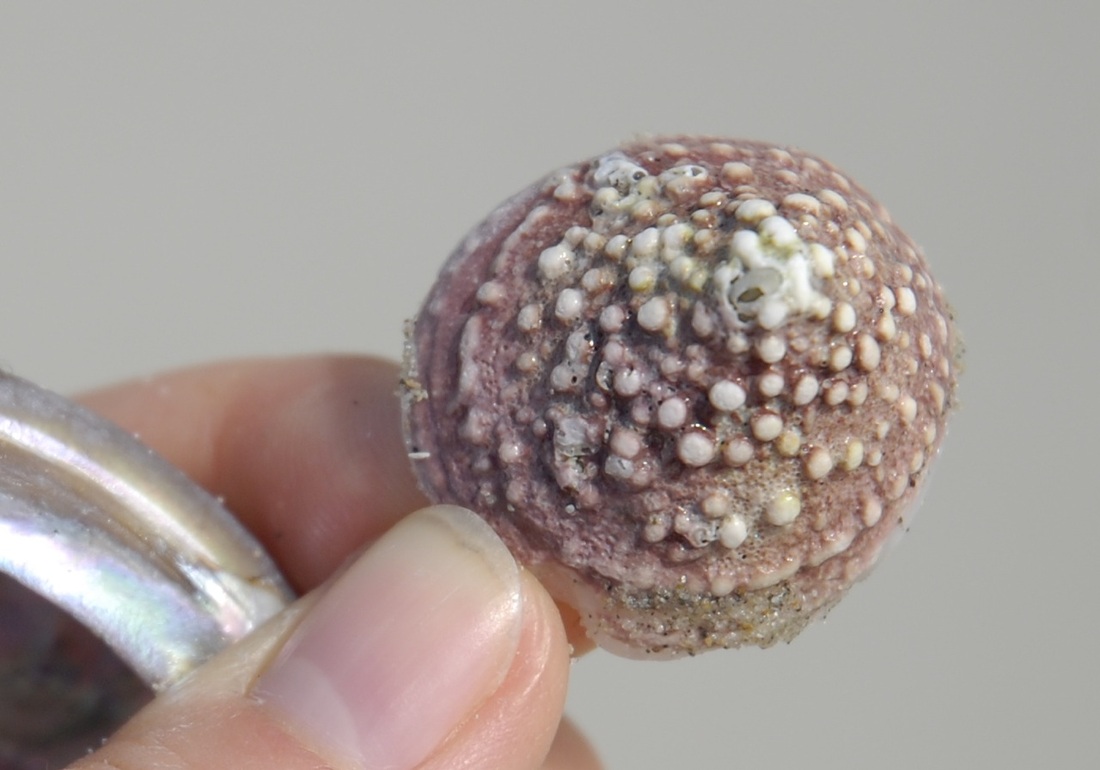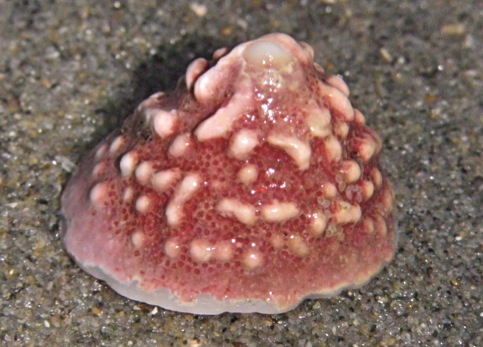Whitecap limpet • Acmaea mitra
{Acmaea mitra = pointed cap}
Identification
The whitecap limpet has a white cone-shaped shell that is usually encrusted with a pinkish coralline red alga, which may also create a knobbly surface texture. The shell is thicker and taller than other limpets - it gets to about 3 cm tall and 3.5 cm in diameter. The shell apex is nearly central. The tall white shell with or without its pinkish algal cover makes this species easy to identify. Click here for photos of different coralline algal growths on whitecap limpets.
Habitat & Range
This limpet species can be found where coralline red algae is present, usually on rocks in the intertidal and shallow subtidal. Shells wash ashore, sometimes still encrusted with live coralline red algae. Its range extends from northern Alaksa to Baja California.
Intriguing Info
The coralline red alga that covers the shell is also the limpet's main food source.
The whitecap limpet has a white cone-shaped shell that is usually encrusted with a pinkish coralline red alga, which may also create a knobbly surface texture. The shell is thicker and taller than other limpets - it gets to about 3 cm tall and 3.5 cm in diameter. The shell apex is nearly central. The tall white shell with or without its pinkish algal cover makes this species easy to identify. Click here for photos of different coralline algal growths on whitecap limpets.
Habitat & Range
This limpet species can be found where coralline red algae is present, usually on rocks in the intertidal and shallow subtidal. Shells wash ashore, sometimes still encrusted with live coralline red algae. Its range extends from northern Alaksa to Baja California.
Intriguing Info
The coralline red alga that covers the shell is also the limpet's main food source.
References
Harbo, R. M. (2011). Whelks to whales: Coastal marine life of the Pacific Northwest. Revised. Madeira Park, BC: Harbour Publishing. P. 139.
Lamb, A., and Hanby, B. (2005). Marine Life of the Pacific Northwest [electronic version]. Madeira Park, BC: Harbour Publishing.
Lunsford, R., Cowles, D., and Helmstetler, H. (2005). Acmaea mitra. Invertebrates of the Salish Sea. Rosario Beach Marine Laboratory. Accessed 18/12/2014.
Authors and editors of page
Kelly Fretwell and Brian Starzomski (2014).
Harbo, R. M. (2011). Whelks to whales: Coastal marine life of the Pacific Northwest. Revised. Madeira Park, BC: Harbour Publishing. P. 139.
Lamb, A., and Hanby, B. (2005). Marine Life of the Pacific Northwest [electronic version]. Madeira Park, BC: Harbour Publishing.
Lunsford, R., Cowles, D., and Helmstetler, H. (2005). Acmaea mitra. Invertebrates of the Salish Sea. Rosario Beach Marine Laboratory. Accessed 18/12/2014.
Authors and editors of page
Kelly Fretwell and Brian Starzomski (2014).






